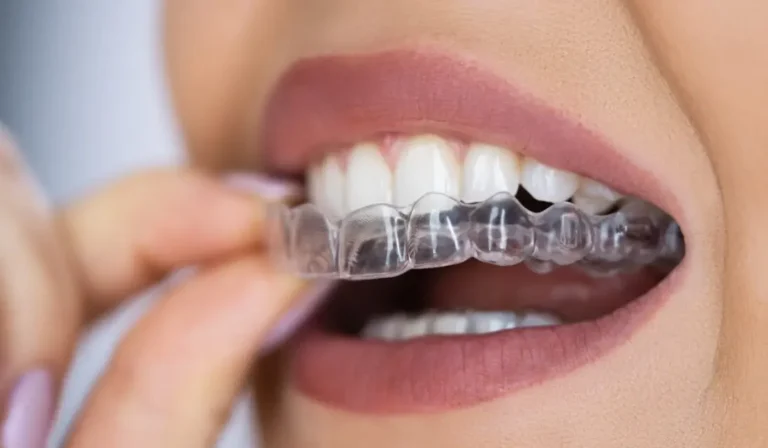Introduction to Invisalign Aligners
In orthodontics, Invisalign aligners present an innovative and discreet solution for correcting dental alignment issues. Unlike traditional braces, these clear aligners offer benefits catering to those seeking an inconspicuous and flexible treatment option. Invisalign aligners are created using 3D imaging technology, ensuring a precise fit tailored to each individual’s dental structure. Customization is key here, making the process efficient and effective for many dental needs.
Whether you are a teenager looking to maintain your style or an adult seeking to boost professional confidence, the appeal of having nearly invisible braces cannot be overstated. Many find the benefits outweigh traditional metal braces in aesthetics, comfort, and convenience. With an emphasis on subtlety and functionality, Invisalign offers a modern twist in the journey to a perfect smile.
Benefits of Choosing Invisalign
A prominent attribute of Invisalign is the convenience of taking out the aligners during meals, beverages, or dental care. This offers considerable adaptability and eliminates the food limitations usually tied to conventional braces. In addition, their transparent design renders them nearly invisible, potentially enhancing self-esteem in situations where appearance is essential, such as social or work environments.
Maintaining oral cleanliness is simpler with Invisalign than with standard braces, which minimizes the chances of plaque accumulation and tooth decay. The lack of metal brackets and wires significantly lessens discomfort, resulting in a more pleasant orthodontic journey. Wearing Invisalign can be a seamless process integrated into daily life, allowing you to maintain a carefree yet responsible approach to dental health.
How Invisalign Works
The process starts with an in-depth consultation using digital imaging to formulate a personalized treatment strategy—the series of aligners gradually shift teeth into their intended alignments, promoting a slow but gentle change. Generally, patients transition to a new set of aligners every one to two weeks. The process involves using advanced technology, such as digital imaging techniques, which ensure each aligner is perfectly tailored and meticulously designed for a perfect fit.
These aligners exert gentle, continuous pressure on the teeth, ensuring minimal discomfort while adequate progress is achieved. Regular check-ups with the orthodontist ensure everything is on track, with adjustments made as necessary to suit individual development. The duration of the treatment can vary based on individual cases, but most treatments last between 12 to 18 months, striking a balance between thoroughness and efficiency.
Cost Factors Involved
The cost of Invisalign can vary greatly and is influenced by multiple factors, such as the case’s complexity, geographical location, and the orthodontist’s expertise. Discussing all potential costs with a specialist is important to understand the financial commitment required for successful treatment. Investing in orthodontal care is a significant decision that often pays off, with increased confidence and an aesthetically pleasing smile as a reward.
While some insurance plans may cover some of the cost, many patients explore financing options to make the investment more manageable. Understanding these options and seeking clear guidance can provide reassurance and save money. Transparency with your orthodontist regarding financial plans allows for a cooperative and supportive treatment journey.
Maintenance and Care
Proper care of Invisalign aligners is paramount to achieving the desired results and ensuring their longevity throughout treatment. Aligners should be cleaned meticulously with warm water and a soft toothbrush to prevent bacterial and plaque buildup. It’s wise to avoid consuming staining foods and drinks while the aligners are worn, maintaining their transparent and discreet appearance. Consider consulting a comprehensive guide dedicated to Invisalign’s success for more in-depth care tips.
Compliance with wearing the aligners for the recommended 20-22 hours daily is essential. Neglecting maintenance can lead to prolonged treatment and potentially affect the final results. An everyday easy-care routine supports speedy progress and maintains the hygiene and integrity of the aligners and teeth.
Technology Advancements in Invisalign
The evolution of technology has seen numerous advancements in Invisalign systems that offer more efficient treatment options, improving patient experiences. Developments such as SmartTrack material and a new aligner material have improved both fit and comfort, offering a more adaptive method of dental correction. Introducing precision wings and other innovations has significantly reduced treatment times while ensuring optimal alignment.
These innovations make the aligners more effective and reduce the treatment time required, maximizing user convenience. Choosing a provider well-versed in these developments can enhance the overall orthodontic experience, guaranteeing access to the latest techniques and products in dental innovation.
Frequently Asked Questions
- How long does treatment typically take? Treatment duration can range from 12 to 18 months, with variability based on the complexity of the dental issues being addressed and individual goals.
- Are there any food restrictions with Invisalign? No, since aligners are removable during meals, allowing for a varied and unrestricted diet.
- Is Invisalign suitable for all ages? While predominantly used by teens and adults, children may require additional evaluations to determine suitability, with alternative solutions often recommended for very young age groups.
Also Read-Understanding the Arbitration Process in Healthcare Payment Disputes
